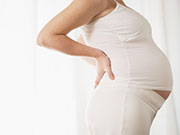- Skip Storing This Everyday Product in the Fridge Door
- Green Tea + B3 Pairing May Boost Brain Health
- Navigating Your Midlife Crisis: Embracing New Possibilities
- City Raccoons Showing Signs of Domestication
- Mapping the Exposome: Science Broadens Focus to Environmental Disease Triggers
- One Week Less on Social Media Linked to Better Mental Health
- Your Brain Changes in Stages as You Age, Study Finds
- Some Suicide Victims Show No Typical Warning Signs, Study Finds
- ByHeart Formula Faces Lawsuits After Babies Sickened With Botulism
- Switch to Vegan Diet Could Cut Your Greenhouse Gas Emissions in Half
Blood Levels of Banned Flame Retardant Drop for Pregnant Women in California


THURSDAY, Sept. 26In good news from California, the state has seen a recent rapid decline in levels of toxic flame retardants in pregnant women’s blood.
These chemicals have been linked to learning problems in children and other health concerns, and the decrease is likely due to their being banned, a new study shows.
Researchers compared 25 women who were tested in 2008 and 2009 and 36 women who were tested in 2011 and 2012. The first group had the highest reported blood levels of polybrominated diphenyl ethers (PBDEs) of any group of pregnant women tested worldwide. But in the second group of women, levels had fallen by two-thirds.
The decline was most likely the result of a statewide ban implemented a decade ago, along with a voluntary national phase-out of the chemicals, the researchers said. But they added that the levels in California fell more quickly than expected, given the longevity of the chemicals in the environment.
“We were pleasantly surprised by the extent of the decline,” study lead author Ami Zota, an assistant professor of environmental and occupational health at the George Washington University School of Public Health and Health Services, said in a University of California, San Francisco news release.
“Regulations can have an impact on people’s everyday lives,” added Zota, who conducted the research while she was a postdoctoral fellow at UCSF’s Program on Reproductive Health.
The study was published online Sept. 25 in the journal Environmental Science & Technology.
PBDEs were used in foam furniture beginning in the 1970s. Animal and human experiments have shown that PBDEs damage a developing baby’s brain, and a strong link has been found between a pregnant woman’s exposure to the chemicals and learning difficulties in her child, according to the news release. The chemicals can also disrupt thyroid hormones in children and adults.
There are a number of ways that PBDEs enter the body. They can wear off foam and turn into household dust, which gets ingested. The chemicals also find their way into people through diets rich in fish, meat and dairy products. This is because PBDEs remain in the environment for a long time and can accumulate up the food chain. Nursing mothers also pass the chemicals to their babies through breast milk.
More in information
Pollution in People has more about PBDEs.
Source: HealthDay
Copyright © 2025 HealthDay. All rights reserved.










